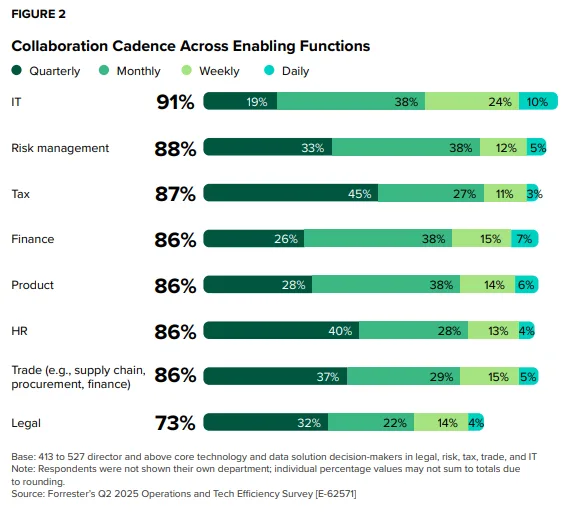Empower your business with the proven benefits of connected workflows and data
Organizations must stay agile and resilient in today’s unpredictable business environment. Digital advances create new opportunities while supply chains face growing risks from tariff uncertainty and changing global regulations.
This environment rewards organizations that adopt proactive, integrated approaches to risk management. Cross-functional risk management empowers teams to identify emerging opportunities, assess strategic advantages, and optimize performance across finance, operations, compliance, legal, and IT functions. To capitalize on these opportunities, business decision-makers can unite diverse teams around shared objectives and implement advanced technology solutions that provide precise risk intelligence and strategic forecasting capabilities.
Jump to ↓
| Challenges of managing risk across teams |
| Study: How teams are managing risks |
| Best practices for a cross-functional risk plan |
| ONESOURCE+: Taking the lead to success |
Challenges of managing risk across teams
Businesses are already well-aware of the types of risk they need to manage—and how complex they’ve become. They include:
- Strategic risks, which include the inability to adapt to a changing business environment and failures in successfully executing strategic plans.
- Operational risks such as process failures, human error, supply-chain problems, and inadequate internal processes. Other potentially dangerous risks include cybersecurity failures (notably data breaches and ransomware attacks) and third-party fraud (such as illicit invoicing and money laundering).
- Financial risks, including market fluctuations, credit defaults, and the inability to meet financial obligations.
- Compliance risks, which involve a failure to adhere to laws, regulations, and internal policies. Noncompliance can result in legal penalties, fines, and damage to the organization’s reputation.
Due to the nature of ever-increasing digital technology integration into business processes, these risks are often interconnected. Cross-functional risk management enables a comprehensive view of interconnected risks by pooling varied expertise and perspectives across teams. That noted, several potential roadblocks can make this approach challenging to put into practice:
- Legacy technology. Out-of-date IT systems and software can hamper collaboration efforts, hindering the ability to recognize complex risks.
- Skill gaps. Current employees may lack the technological or management expertise needed for integration.
- Less-than-optimal data quality. Some of the data an organization has collected and stored may be outdated or inaccurate, and there may be contradictions between data in different departments.
- Siloed data. Even when the data is useful, it is often spread across various departments, making it harder to extract actionable risk management insights.
But while digital technology has introduced greater risk complexity, it also can help businesses address it more effectively and with greater resilience.
Study: How teams are managing risks
Connected workflows and unified data streams are reshaping how businesses identify, assess, and respond to risk across functions. And they’re requiring organizations to shift from ad hoc risk practices that vary from department to department to a more integrated framework.
Recently, Thomson Reuters commissioned Forrester Consulting to evaluate how a more integrated tech stack across business functions can improve the execution of strategic business objectives. Forrester surveyed 527 director-level and above respondents in North America and Europe at large and midsize organizations. Thomson Reuters released the study in October 2025.
Among its key findings, the study reveals that even with the interconnection of risk, collaboration between departments remains erratic. Additionally, the technology solutions used by different functional teams within an organization typically don’t communicate (or, integrate) with each other.
Forrester defines insights-driven businesses as those that break down silos and sync data, analytics, and optimization capabilities across their teams. The study demonstrates that the most successful of these organizations are incorporating AI into their tech systems. AI tools can rapidly analyze large datasets while validating and testing data accuracy. This allows these businesses to make faster and more accurate decisions in response to the risks of a volatile market environment. Solutions developed for specific enterprises can help those businesses better predict and prepare for financial, supply, compliance, and market risks.
Best practices for a cross-functional risk plan
All teams —finance, operations, compliance, technology, and strategy—can benefit from a well-integrated cross-functional risk management plan. As seen below in Figure 2 from Forrester Consulting Thought Leadership Paper, these departments are already intertwined. Closer collaboration between corporate functions can enable more efficient and insights-driven risk monitoring and mitigation.

A commissioned study conducted by Forrester Consulting on behalf of Thomson Reuters, Oct., 2025.
Still, different departments can have varying visions of what risks take priority and how the organization should address them. To overcome hurdles like these, businesses should consider incorporating these best practices for successfully implementing cross-functional risk management.
- Above all, an enterprise needs to build a collaborative culture. This includes establishing a clear governance structure with defined roles and effective communication channels. Clearly, this approach requires buy-in and encouragement from top executives.
- Cross-functional risk management programs also should align with an organization’s overall objectives—objectives that all business functions recognize and pursue.
- Departments should use common technology solutions that deliver connected data sharing and workflow capabilities. Organizations can enhance this by seamlessly integrating tech solutions from the same vendor.
- Businesses should pursue continuous improvement in their cross-functional risk management plans. After all, risks are constantly evolving and changing.
By following best practices like these, organizations can develop more practical, agile, and robust risk plans. This, in turn, will lower their risk management costs, strengthen market competitiveness, and enhance regulatory compliance.

Assessment
Has your organization optimized AI and tech across its business enabling functions?
Take quiz ↗ONESOURCE+: Taking the lead to success
Organizations implementing these best practices need technology solutions that can deliver on the promise of truly connected risk management. Thomson Reuters ONESOURCE+ exemplifies how integrated platforms can transform cross-functional collaboration by uniting tax, accounting, and compliance processes within a single, intelligent ecosystem.
ONESOURCE+ demonstrates the power of connected workflows through its ability to seamlessly integrate data across multiple business functions. The platform’s AI-powered analytics provide real-time risk intelligence that enables finance, tax, and compliance teams to identify emerging threats before they impact business operations. By consolidating previously siloed processes, ONESOURCE+ eliminates the data fragmentation that often undermines effective risk management.
What sets Thomson Reuters solutions apart is our deep understanding that risk management isn’t just about technology—it’s about empowering professionals with the insights they need to make confident decisions. Our platforms combine comprehensive global content with advanced workflow automation, ensuring that cross-functional teams have access to the same trusted information and can collaborate effectively regardless of their specific domain expertise. The integration capabilities of Thomson Reuters solutions directly address the core challenges identified in the Forrester research—legacy system limitations, data silos, and inconsistent collaboration patterns—by enabling organizations to break down departmental barriers while maintaining the specialized functionality each team requires to excel in their specific risk management responsibilities.
Ready to enhance your cross-functional risk management approach? Explore our comprehensive suite of corporate software solutions designed to provide actionable insights, improve operational efficiency, and boost productivity across your entire organization.

Corporate software and solutions
Trusted, AI-powered solutions for an intelligent compliance network
View more ↗









